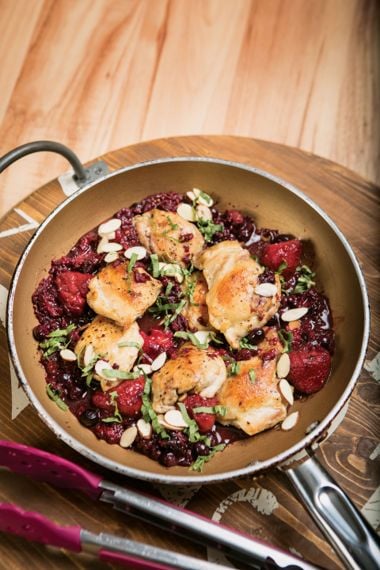
Bored with basic chicken? It may seem counterintuitive, but simmering chicken alongside berries produces tender meat that is further enhanced by a complex sweet sauce that’s sure to become a family favourite.
Nutrition bonus
Berries are an excellent source of potent antioxidants that may help improve brain functioning. One study found that cooking does not degrade blueberries’ antioxidant power.Why thighs?
Darker meat chicken thighs add an extra juicy goodness to meals. The flavour they deliver is worth the small amount of extra fat they contain compared to chicken breast.Chicken with Berry Sauce
Ingredients
- 1 1/4 lb (575 g) boneless, skinless organic chicken thighs
- Salt and black pepper, to taste
- 2 tsp (10 mL) grapeseed, sunflower, or camelina oil
- 2 shallots, chopped
- 2 garlic cloves, minced
- 1 tsp (5 mL) mustard seeds (optional)
- 1/2 cup (125 mL) low-sodium chicken broth
- 3 cups (750 mL) frozen mixed berry medley, unthawed
- 3 sprigs fresh thyme
- 2 Tbsp (30 mL) balsamic vinegar
- 1/4 tsp (1 mL) cayenne pepper
- 1/4 tsp (1 mL) cinnamon
- 1 tsp (5 mL) lemon zest
- 2 Tbsp (30 mL) sliced almonds
- 2 Tbsp (30 mL) sliced fresh basil
Nutrition
Per serving:
- calories304
- protein31g
- fat12g
- saturated fat2g
- trans fat0g
- carbohydrates17g
- sugars8g
- fibre5g
- sodium146mg
Directions
01
Season chicken with salt and pepper. Heat large skillet or large heavy-bottomed saucepan over medium-high heat. Add oil, swirl to coat, and, once shimmering, place chicken in pan. Cook until browned on bottom side, flip and sear until browned on the other side, about 4 minutes total.
02
Remove chicken from pan and set aside. Add shallot, garlic, and mustard seeds (if using) to pan; heat for 1 minute, stirring often. Place broth in skillet and scrape up any brown bits from bottom of pan. Add berries, thyme, vinegar, cayenne, and cinnamon to pan. Bring to a simmer, return chicken to pan, reduce heat to medium-low, and simmer gently until chicken is cooked through, about 15 minutes.
03
Remove chicken from pan and set aside. Stir in lemon zest; raise heat to high and boil sauce until slightly thickened, about 6 minutes, scraping bottom of pan occasionally.
04
Serve chicken topped with berry sauce and garnished with almonds and basil.





